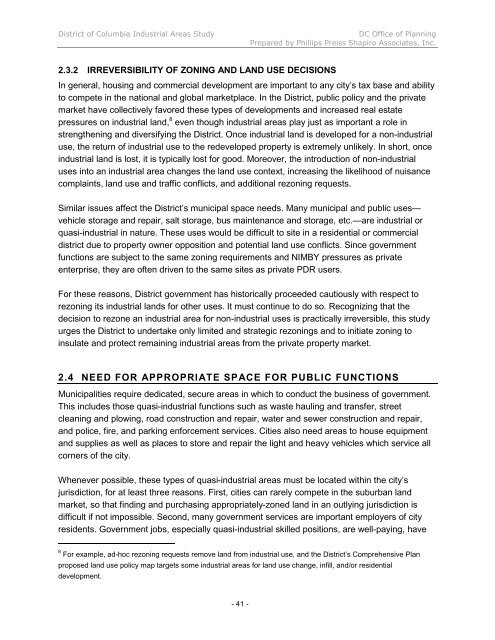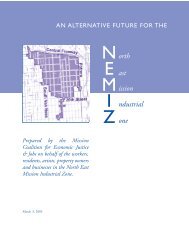INDUSTRIAL LAND IN A POST-INDUSTRIAL CITY District of ...
INDUSTRIAL LAND IN A POST-INDUSTRIAL CITY District of ...
INDUSTRIAL LAND IN A POST-INDUSTRIAL CITY District of ...
You also want an ePaper? Increase the reach of your titles
YUMPU automatically turns print PDFs into web optimized ePapers that Google loves.
<strong>District</strong> <strong>of</strong> Columbia Industrial Areas Study DC Office <strong>of</strong> Planning<br />
Prepared by Phillips Preiss Shapiro Associates, Inc.<br />
2.3.2 IRREVERSIBILITY OF ZON<strong>IN</strong>G AND <strong>LAND</strong> USE DECISIONS<br />
In general, housing and commercial development are important to any city’s tax base and ability<br />
to compete in the national and global marketplace. In the <strong>District</strong>, public policy and the private<br />
market have collectively favored these types <strong>of</strong> developments and increased real estate<br />
pressures on industrial land, 8 even though industrial areas play just as important a role in<br />
strengthening and diversifying the <strong>District</strong>. Once industrial land is developed for a non-industrial<br />
use, the return <strong>of</strong> industrial use to the redeveloped property is extremely unlikely. In short, once<br />
industrial land is lost, it is typically lost for good. Moreover, the introduction <strong>of</strong> non-industrial<br />
uses into an industrial area changes the land use context, increasing the likelihood <strong>of</strong> nuisance<br />
complaints, land use and traffic conflicts, and additional rezoning requests.<br />
Similar issues affect the <strong>District</strong>’s municipal space needs. Many municipal and public uses—<br />
vehicle storage and repair, salt storage, bus maintenance and storage, etc.—are industrial or<br />
quasi-industrial in nature. These uses would be difficult to site in a residential or commercial<br />
district due to property owner opposition and potential land use conflicts. Since government<br />
functions are subject to the same zoning requirements and NIMBY pressures as private<br />
enterprise, they are <strong>of</strong>ten driven to the same sites as private PDR users.<br />
For these reasons, <strong>District</strong> government has historically proceeded cautiously with respect to<br />
rezoning its industrial lands for other uses. It must continue to do so. Recognizing that the<br />
decision to rezone an industrial area for non-industrial uses is practically irreversible, this study<br />
urges the <strong>District</strong> to undertake only limited and strategic rezonings and to initiate zoning to<br />
insulate and protect remaining industrial areas from the private property market.<br />
2.4 NEED FOR APPROPRIATE SPACE FOR PUBLIC FUNCTIONS<br />
Municipalities require dedicated, secure areas in which to conduct the business <strong>of</strong> government.<br />
This includes those quasi-industrial functions such as waste hauling and transfer, street<br />
cleaning and plowing, road construction and repair, water and sewer construction and repair,<br />
and police, fire, and parking enforcement services. Cities also need areas to house equipment<br />
and supplies as well as places to store and repair the light and heavy vehicles which service all<br />
corners <strong>of</strong> the city.<br />
Whenever possible, these types <strong>of</strong> quasi-industrial areas must be located within the city’s<br />
jurisdiction, for at least three reasons. First, cities can rarely compete in the suburban land<br />
market, so that finding and purchasing appropriately-zoned land in an outlying jurisdiction is<br />
difficult if not impossible. Second, many government services are important employers <strong>of</strong> city<br />
residents. Government jobs, especially quasi-industrial skilled positions, are well-paying, have<br />
8 For example, ad-hoc rezoning requests remove land from industrial use, and the <strong>District</strong>’s Comprehensive Plan<br />
proposed land use policy map targets some industrial areas for land use change, infill, and/or residential<br />
development.<br />
- 41 -












